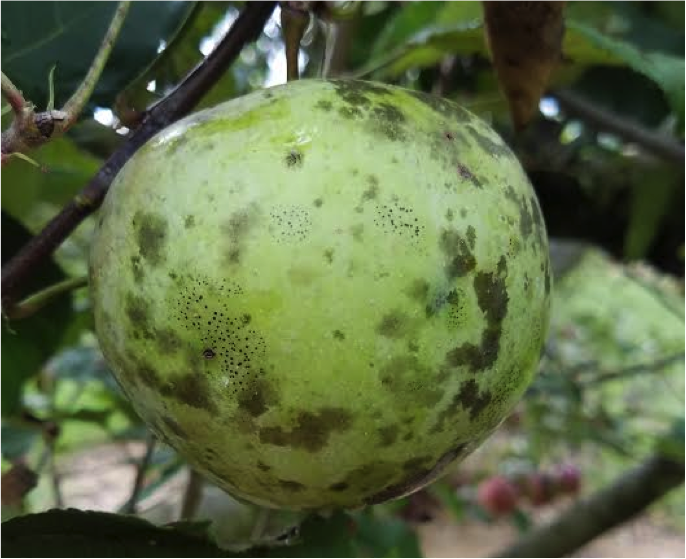Apple Disease Update: Week of June 24
go.ncsu.edu/readext?533993
en Español / em Português
El inglés es el idioma de control de esta página. En la medida en que haya algún conflicto entre la traducción al inglés y la traducción, el inglés prevalece.
Al hacer clic en el enlace de traducción se activa un servicio de traducción gratuito para convertir la página al español. Al igual que con cualquier traducción por Internet, la conversión no es sensible al contexto y puede que no traduzca el texto en su significado original. NC State Extension no garantiza la exactitud del texto traducido. Por favor, tenga en cuenta que algunas aplicaciones y/o servicios pueden no funcionar como se espera cuando se traducen.
Português
Inglês é o idioma de controle desta página. Na medida que haja algum conflito entre o texto original em Inglês e a tradução, o Inglês prevalece.
Ao clicar no link de tradução, um serviço gratuito de tradução será ativado para converter a página para o Português. Como em qualquer tradução pela internet, a conversão não é sensivel ao contexto e pode não ocorrer a tradução para o significado orginal. O serviço de Extensão da Carolina do Norte (NC State Extension) não garante a exatidão do texto traduzido. Por favor, observe que algumas funções ou serviços podem não funcionar como esperado após a tradução.
English
English is the controlling language of this page. To the extent there is any conflict between the English text and the translation, English controls.
Clicking on the translation link activates a free translation service to convert the page to Spanish. As with any Internet translation, the conversion is not context-sensitive and may not translate the text to its original meaning. NC State Extension does not guarantee the accuracy of the translated text. Please note that some applications and/or services may not function as expected when translated.
Collapse ▲ For this week’s Apple Disease Update, I’d like to share some very preliminary observations from this year’s Glomerella leaf spot trial at MHCREC. Hopefully this will serve to keep everyone optimistic regarding GLS and bitter rot as the season progresses!
For this week’s Apple Disease Update, I’d like to share some very preliminary observations from this year’s Glomerella leaf spot trial at MHCREC. Hopefully this will serve to keep everyone optimistic regarding GLS and bitter rot as the season progresses!
- In Mills River, symptoms of GLS on ‘Tenroy Gala’ appeared around the same time as last year and disease is progressing on non-sprayed trees at a nearly identical rate as in 2017.
- For the third year in a row, DMI (FRAC 3) fungicides are continuing to perform poorly against GLS in our research orchard. While I would encourage use of these fungicides for flyspeck/sooty blotch management, I would not count on any DMI fungicide for GLS/bitter rot control in apple.
- In standalone SDHI fungicides (FRAC 7) that we’ve evaluated, there seems to be two groups of efficacy: those that provide little to no control against GLS and those that provide at least 50% control against GLS if not more. Sercadis (fluxapyroxad) is part of the former group while Aprovia (benzovindiflupyr) and Fontelis (penthiopyrad) have shown pretty decent efficacy in the field and also in the lab. If an extended period of rain is predicted (>2 inches), you may want to consider combining Aprovia with Captan + ProPhyt in the tank mixture to provide some residual activity. Aprovia is also an excellent material against flyspeck/sooty blotch.
- Despite nearly 25″ of rain in some areas on Henderson County in May, Captan (full rate) or Captan + ProPhyt have so far provided exceptional control against GLS when applied on a 7 day interval in our research plot at MHCREC.
- Merivon and other FRAC 11 containing products continue to perform as well, but to date not necessarily better than multi-site protectants.
Disease Management Game Plan for the Week of June 24
- Glomerella leaf spot/bitter rot: Maintain shortened intervals (7 to 10) days of a Captan + ProPhyt (or a different phosphorous acid product). Coverage and maintaining residues are IMPORTANT so make sure to reapply ASAP if 2+ inches of rain occurs in your orchard. In blocks where you’ve had bitter rot problems in the past, also consider removing any dropped apples (resulting from either hand-thinning or June drop) from the orchard and destroying. I often observe bitter rot on these fallen apples and they can likely serve as an important source of inoculum for later season infections.
- Flyspeck/Sooty Blotch: Generally speaking, management of FSSB should be taken care of as a result of GLS applications. Like GLS, fungicide residue is important for FSSB control. In FSSB fungicide trials at MHCREC in 2017, Aprovia, Captan+ ProPhyt, Merivon, and Inspire Super all provided statistically equivalent levels of control against the disease when applied during cover applications (94-100% control). Captan applied at a full rate (without ProPhyt), Cueva or Oso rotated with Captan, and Prophyt (6 pt, no captan in tank mix) moderate control (50-85%) against the disease.


